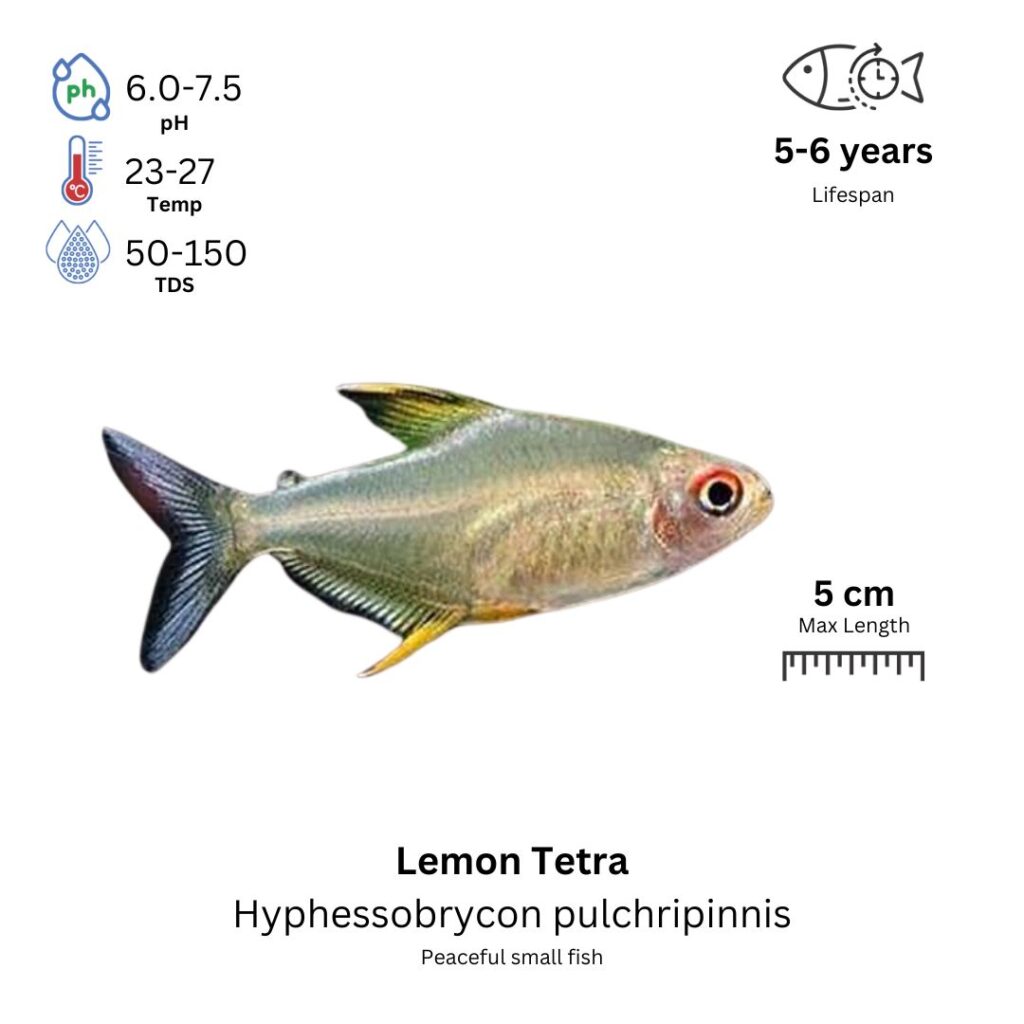Lemon Tetra
Hyphessobrycon pulchripinnis

Description
The Lemon Tetra is a small and peaceful freshwater fish known for its striking lemon-yellow coloration. This species has a transparent, light body with a soft yellow hue that becomes more intense in well-maintained aquariums. The males of the species often exhibit more vivid yellow colors, while females are generally a bit paler. They have a slender, streamlined body with a small, upturned mouth. Lemon Tetras are social, peaceful fish that do well in schools, and they are usually seen swimming in the middle to upper regions of the tank. Their calm and graceful movements make them an attractive and low-maintenance addition to community aquariums.
Habitat Origin
Native to the rivers and streams of South America, particularly in the Amazon Basin, Brazil, and Venezuela. They are typically found in slow-moving waters with clear, slightly acidic water and dense vegetation. The natural environment of the Lemon Tetra includes areas with submerged plants and roots, providing them with hiding spots and grazing areas.
Aquarium
Ideal Number in Aquarium: At least 6 individuals, as they are schooling fish and feel more secure in groups.
Favorite Food

Lemon Tetras are omnivores and will accept a variety of foods, including high-quality flake food, micro pellets, and live or frozen foods such as brine shrimp, daphnia, and bloodworms. They will also graze on small plant matter and algae, making them well-suited for planted tanks. A varied diet ensures they maintain their bright coloration and healthy physique.
Behavior:
Lemon Tetras are peaceful and social, thriving in schools. They are generally calm and non-aggressive, making them ideal for community tanks. They prefer to swim in groups and feel more secure when kept in schools of at least 6 individuals. They are active swimmers, typically seen darting through the middle and upper parts of the tank. Their peaceful nature allows them to coexist with other small, non-aggressive fish. They are not fin-nippers, and they do well in a peaceful tank setup.
Special Care:
Lemon Tetras thrive in a well-planted tank with plenty of hiding spots, such as plants, rocks, and driftwood. A fine gravel or sandy substrate is ideal for them to forage naturally. Regular water changes and good filtration are essential for maintaining water quality, as they are sensitive to poor conditions. Stable water parameters, especially pH and temperature, are crucial to keeping Lemon Tetras healthy and vibrant. They enjoy moderate water flow, mimicking their natural habitat in the wild.
Compatibility with Other Fish:
Yes, Lemon Tetras are ideal for peaceful community aquariums with other small, non-aggressive species. They are compatible with species like other tetras, rasboras, small catfish, and peaceful shrimp. Avoid keeping them with larger or more aggressive fish, as they may become stressed or be eaten. Lemon Tetras do best when housed with species that occupy different parts of the tank (such as bottom dwellers or mid-level swimmers).
Breeding Setup
A separate breeding tank is highly recommended for Lemon Tetras to prevent egg predation and maintain stable water conditions. A 10-gallon tank (38 liters) is suitable for small groups, while a 20-gallon tank (75 liters) works better for multiple pairs. Keep water slightly acidic to neutral (pH 6.0–7.5), with a temperature of 24–28°C (75–82°F) and hardness of 4–12 dGH. Use a gentle sponge filter, fine substrate, and plenty of live and floating plants like Java moss and Water Sprite to provide cover for eggs and fry. Maintain moderate lighting on a 12-hour light/dark cycle to support breeding behavior.
Conditioning for Breeding
To prepare Lemon Tetras for spawning, feed a nutrient-rich, varied diet including high-quality flakes, live/frozen foods (brine shrimp, daphnia, bloodworms), and vegetables like chopped peas or spinach. This helps ensure healthy egg production and strong fry. Carry out weekly 20–30% water changes to keep the water clean. To induce spawning, simulate the rainy season by performing a 50% water change and raising the temperature to 28°C (82°F).
Spawning Process
Spawning generally occurs in the early morning after optimal water changes. Males show off their bright yellow coloration while courting females. The female scatters 30–100 sticky eggs, which are fertilized by the male and adhere to plants, substrate, or decor. Once eggs are laid, immediately remove the adults to prevent them from eating the eggs or newly hatched fry, which is common in egg-scattering tetras.
Fry Care
The eggs hatch in about 24–36 hours, depending on water temperature. Fry feed off their yolk sacs for the first few days, then transition to infusoria or liquid fry food. As they grow, offer baby brine shrimp, microworms, or crushed flakes. Maintain stable temperature (24–28°C) and perform daily or alternate-day 10–20% water changes. Avoid overfeeding, which can pollute the water and endanger fry health.
Key Considerations
Lemon Tetras reach breeding maturity at around 6–12 months. Males are slimmer and more vividly colored, especially in the fins, while females are rounder and less vibrant, particularly when carrying eggs. Avoid stressors like rapid water changes or aggressive tank mates. Clean water, stable conditions, and a peaceful environment are essential for successful breeding and healthy fry development.
